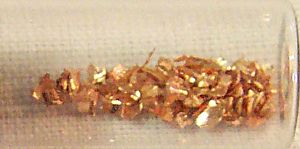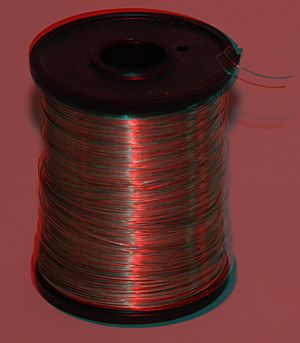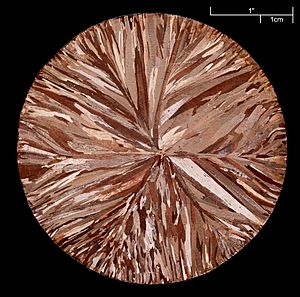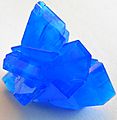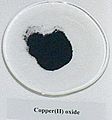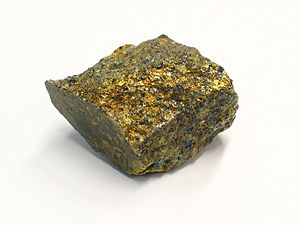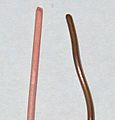Copper facts for kids
Copper is a special kind of chemical element. It's number 29 on the periodic table, which is like a big chart of all known elements. Its symbol is "Cu." This comes from the Latin word cuprum. That word came from the island of Cyprus, where a lot of copper was found long ago. Copper is a transition metal, found in the middle part of the periodic table.
Contents
What is Copper Like?
How Copper Looks and Feels
When copper is brand new and pure, it looks reddish-orange. But if you leave it out in the air, it quickly gets a reddish coating called a tarnish.
Copper is one of the few metals that has a strong color. Most metals are gray or silver. Only gold, copper, caesium, and osmium have distinct colors. Over time, copper can turn green. This happens when it reacts with air and forms something called green copper carbonate. You might have seen this green color on old copper roofs or statues like the Statue of Liberty. This green layer is called verdigris.
Copper is very flexible. You can easily stretch it into thin wires. This is called being ductile. It's also quite soft. You can scratch it with a steel pocketknife, but not with your fingernail.
Copper doesn't dissolve in weak acids. But it can react with some stronger liquids, especially if they contain oxygen. For example, it can dissolve in nitric acid to make a blue liquid called copper(II) nitrate.
Copper's Chemical Friends (Compounds)
Copper likes to join with other elements to form chemical compounds. In these compounds, copper usually has two main "states": +1 and +2. The +2 state is more common. Most compounds with copper in the +2 state are blue. Compounds with copper in the +1 state can be white.
Copper compounds are like weak "cleaners" for other metals. They can make other metals rust or break down, while the copper is left behind. For example, if you put iron in a blue liquid called copper(II) sulfate, the iron will turn into iron(II) sulfate, and pure copper will appear!
Copper compounds can be many colors, like black, green, reddish, white, blue, or yellow.
Copper(I) Compounds
These compounds have copper in its +1 state. They are not very stable in air. They often react with air to change into copper(II) compounds. Most of them do not dissolve in water.
- Copper(I) chloride: This is white when it's pure, but it turns green when it touches air.
- Copper(I) oxide: This compound is reddish-brown.
Copper(II) Compounds
These compounds have copper in its +2 state. They are more stable in air than copper(I) compounds. Many of them are greenish if they have water molecules attached.
- Copper(II) carbonate: This is the greenish stuff that forms on copper when it's exposed to air.
- Copper(II) chloride: This is greenish when it has water, and brown when it's dry.
- Copper(II) hydroxide: This is a light blue compound.
- Copper(II) oxide: This compound is black.
- Copper(II) sulfate: This is a very common copper compound and is usually blue.
Where is Copper Found?
You can find copper as a pure metal in the ground, though it often has a green coating on the outside. But most copper is found mixed with other elements in chemical compounds. The most common copper ore (rock with metal in it) is called Chalcopyrite. It's a mix of iron and copper.
Copper is also found in tiny amounts in living things. Some sea creatures like mollusks (snails, clams) and arthropods (insects, crabs) have blue blood because it contains copper! Humans and other mammals have red blood because our blood contains iron instead.
How is Copper Used?
Copper has been used for a very long time. Some of the oldest tools ever found are made of copper!
Today, copper is used in many ways:
- Electrical Wires: Copper is excellent for electrical wires because it can be stretched easily and conducts electricity very well. It's also not too expensive.
- Pipes: It's used for water pipes because it doesn't rust easily.
- Statues: The Statue of Liberty is made of copper!
- Heat Sinks: It can be used in things that need to get rid of heat, like in computers.
Copper is also mixed with other metals to make new, stronger metals:
- When copper is mixed with tin, it makes bronze. Bronze is much harder than pure copper. It was so important that a whole time period was named after it: the Bronze Age.
- When copper is mixed with zinc, it makes brass. Brass is even harder than bronze.
- When copper is mixed with nickel, it makes cupronickel, which is often used in coins.
Copper and Your Body (Nutrition)
Copper is a very important trace element for plants and animals, including humans. This means your body needs a small amount of it to work properly. An average person has about 1.4 to 2.1 milligrams of copper for every kilogram of their body weight.
Your body gets copper from the food you eat. It's absorbed in your gut and then sent to your liver. From there, it travels to other parts of your body.
Experts recommend how much copper you should get each day:
- Ages 9–13: 700 micrograms (μg)
- Ages 14–18: 890 micrograms (μg)
- Ages 19 and older: 900 micrograms (μg)
For example, 900 micrograms is less than one milligram, so you only need a tiny bit! Foods rich in copper include oysters, liver, nuts, and cocoa.
If you don't get enough copper, it can cause problems like feeling tired (like anemia) or having weaker bones. On the other hand, a rare disease called Wilson's disease causes too much copper to build up in the body, which can be harmful.
Is Copper Safe?
Pure copper metal is not very harmful. However, some copper compounds can be toxic if you get too much of them. Luckily, your body is good at getting rid of extra copper, so it usually doesn't build up to dangerous levels.
How is Copper Made Pure?
Sometimes, copper is found as a pure metal in the ground and just needs to be shaped. But most copper comes from ores like chalcopyrite.
Here's a simplified way copper is made pure: 1. Heating the Ore: Chalcopyrite ore is heated with air. This helps separate the iron from the copper and creates a gas called sulfur dioxide. 2. Removing Iron: Sand (silicon dioxide) is added. It reacts with the iron to form a liquid that can be drained away. 3. Making Impure Copper: What's left is mostly copper and sulfur. This mixture is heated again with air, which turns it into copper metal and more sulfur dioxide. This copper is not perfectly pure yet.
To make copper very pure, a process called electrolysis is used.
- A thin sheet of pure copper is placed on one side (the cathode).
- A thick sheet of impure copper is placed on the other side (the anode).
- Both are put into a blue liquid called copper sulfate.
- When electricity passes through, the impure copper dissolves into the liquid. The pure copper then sticks to the thin sheet, making it thicker and very pure.
Recycling Copper
Copper is very valuable, and we are using up the copper in the ground. Luckily, copper can be recycled over and over again without losing its quality! It's one of the most recycled metals, after iron and aluminum. About 80% of all the copper ever dug up is still being used today!
Recycling copper is similar to how it's first made pure, but it takes fewer steps. High-quality scrap copper is simply melted down and shaped into new pieces. Lower-quality scrap copper is refined using the same electrolysis process mentioned above.
See also
 In Spanish: Cobre para niños
In Spanish: Cobre para niños
Images for kids
-
The East Tower of the Royal Observatory, Edinburgh, showing new copper (bright) next to old copper (green).
-
Coins often use copper alloys. Here are US dimes (made of cupronickel) and an older Canadian dime (silver and copper).
-
An old copper ingot (a block of metal) from ancient Crete, shaped like an animal skin.
-
A replica of Ötzi the Iceman's axe. Its blade is made of copper, showing how copper was used in tools during the Copper Age.
-
An 18th-century copper kettle from Norway.
-
The copper roof of the Minneapolis City Hall, which has turned green over time.


